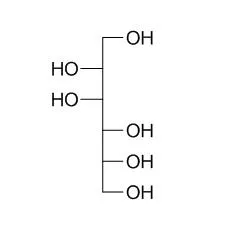| Description: |
D-Mannitol, a specific hydroxyl free radical scavenger, can reduce the developmental toxicity of hydroxyurea in rabbits; it has thermal properties and could be as a Phase Change Material (PCM) for latent heat storage system; it is a potential diagnostic marker for aspergillosis. D-mannitol has neuroprotectant effect in reducing the sensory neurological disturbances seen in ciguatera poisoning, it does not act purely as an osmotic agent to reduce swelling of nerves, but involves a more complex action dependent on the Na(v) channel subtype, possibly to alter or reduce toxin association. |
| Targets: |
Sodium Channel | DNA/RNA Synthesis |
| In vitro: |
| Neuropharmacology. 2005 Oct;49(5):669-86. | | Neuroprotectant effects of iso-osmolar D-mannitol to prevent Pacific ciguatoxin-1 induced alterations in neuronal excitability: a comparison with other osmotic agents and free radical scavengers.[Pubmed: 15950247] |
METHODS AND RESULTS:
The basis for the neuroprotectant effect of D-Mannitol in reducing the sensory neurological disturbances seen in ciguatera poisoning, is unclear. Pacific ciguatoxin-1 (P-CTX-1), at a concentration 10 nM, caused a statistically significant swelling of rat sensory dorsal root ganglia (DRG) neurons that was reversed by hyperosmolar 50 mM D-Mannitol. However, using electron paramagnetic resonance (EPR) spectroscopy, it was found that P-CTX-1 failed to generate hydroxyl free radicals at concentrations of toxin that caused profound effects on neuronal excitability. Whole-cell patch-clamp recordings from DRG neurons revealed that both hyper- and iso-osmolar 50 mM D-Mannitol prevented the membrane depolarisation and repetitive firing of action potentials induced by P-CTX-1. In addition, both hyper- and iso-osmolar 50 mM D-Mannitol prevented the hyperpolarising shift in steady-state inactivation and the rise in leakage current through tetrodotoxin (TTX)-sensitive Na(v) channels, as well as the increased rate of recovery from inactivation of TTX-resistant Na(v) channels induced by P-CTX-1. D-Mannitol also reduced, but did not prevent, the inhibition of peak TTX-sensitive and TTX-resistant I(Na) amplitude by P-CTX-1. Additional experiments using hyper- and iso-osmolar D-sorbitol, hyperosmolar sucrose and the free radical scavenging agents Trolox and L-ascorbic acid showed that these agents, unlike D-Mannitol, failed to prevent the effects of P-CTX-1 on spike electrogenesis and Na(v) channel gating.
CONCLUSIONS:
These selective actions of D-Mannitol indicate that it does not act purely as an osmotic agent to reduce swelling of nerves, but involves a more complex action dependent on the Na(v) channel subtype, possibly to alter or reduce toxin association. |
|
| In vivo: |
| J Infect Dis. 1989 Jul;160(1):95-103. | | Increased amounts of the Aspergillus metabolite D-mannitol in tissue and serum of rats with experimental aspergillosis.[Pubmed: 2499640] | Several Aspergillus species produce large amounts of the hexitol D-Mannitol in vitro, but it is not known whether these species also produce D-Mannitol in vivo.
METHODS AND RESULTS:
Serum samples and homogenized tissues were analyzed from rats pretreated with cortisone and cyclophosphamide and then given 2 x 10(6) preincubated conidia of Aspergillus fumigatus intravenously.
The resulting infection was lethal by 48 h and was characterized by much more severe disease in the liver than in the kidneys, spleen, or lungs. A compound present in increased amounts in the livers and sera of the infected rats was shown to be D-Mannitol by gas chromatography (GC) and GC/mass spectrometry and enzymatically. Quantitative analysis by GC showed that the infected rats had more D-Mannitol in their livers (but not in their lungs or kidneys) after 12 h (P less than .01 at 12, 24, and 36 h) and higher serum D-Mannitol concentrations and serum D-Mannitol/creatinine ratios after 36 h (P less than .05) than did uninfected controls.
CONCLUSIONS:
These results indicate that A. fumigatus can produce and release sufficient D-Mannitol in the tissues of infected animals to raise serum D-Mannitol levels. Thus, D-Mannitol is a potential diagnostic marker for aspergillosis. |
|






 Cell. 2018 Jan 11;172(1-2):249-261.e12. doi: 10.1016/j.cell.2017.12.019.IF=36.216(2019)
Cell. 2018 Jan 11;172(1-2):249-261.e12. doi: 10.1016/j.cell.2017.12.019.IF=36.216(2019) Cell Metab. 2020 Mar 3;31(3):534-548.e5. doi: 10.1016/j.cmet.2020.01.002.IF=22.415(2019)
Cell Metab. 2020 Mar 3;31(3):534-548.e5. doi: 10.1016/j.cmet.2020.01.002.IF=22.415(2019) Mol Cell. 2017 Nov 16;68(4):673-685.e6. doi: 10.1016/j.molcel.2017.10.022.IF=14.548(2019)
Mol Cell. 2017 Nov 16;68(4):673-685.e6. doi: 10.1016/j.molcel.2017.10.022.IF=14.548(2019)